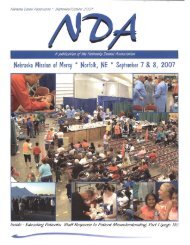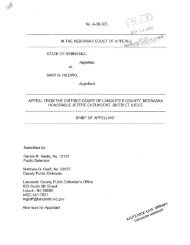Financial Articulation of a Fiduciary Duty to Bondholders with ...
Financial Articulation of a Fiduciary Duty to Bondholders with ...
Financial Articulation of a Fiduciary Duty to Bondholders with ...
You also want an ePaper? Increase the reach of your titles
YUMPU automatically turns print PDFs into web optimized ePapers that Google loves.
1986] FIDUCIARY DUTY TO BONDHOLDERS<br />
D. EFFICIENT MARKET PORTFOLIOS<br />
Risk (variance) has two components: diversifiable risk (which is<br />
risk that can be eliminated by investment diversification) and covariance<br />
risk (which is the nondiversifiable residual risk). 5 2 A "riskaverse"<br />
inves<strong>to</strong>r eschews specified risk (the variance <strong>of</strong> outcomes in<br />
an investment) in favor <strong>of</strong> its economically equivalent certainty (the<br />
expected value <strong>of</strong> the investment), whereas a "risk-liking" inves<strong>to</strong>r<br />
seeks such risk as against such certainty. A "risk-neutral" inves<strong>to</strong>r is<br />
indifferent <strong>to</strong> such risk or <strong>to</strong> such certainty. 53<br />
The intertemporal capital-asset-pricing model 54 can be developed<br />
from the addition <strong>of</strong> three postulates <strong>to</strong> those <strong>of</strong> the Black-Scholes<br />
option-pricing framework: 55 (1) all inves<strong>to</strong>rs are risk-averse, 5 6 (2) all<br />
inves<strong>to</strong>rs have restricted mathematical forms <strong>of</strong> risk aversion and/or<br />
all investments have restricted mathematical forms <strong>of</strong> returns 5 7 and<br />
(3) all inves<strong>to</strong>rs simultaneously possess identical investment facts and<br />
5 8<br />
beliefs. In the intertemporal capital-asset-pricing model, all inves<strong>to</strong>rs<br />
agree on the price <strong>of</strong> instantaneous covariance risk 5 9 and all in-<br />
ves<strong>to</strong>rs own (in varying quantities) equal proportions <strong>of</strong> each<br />
6 0<br />
corporation's securities invested in.<br />
"[O]ptimum portfolios for all inves<strong>to</strong>rs" are combinations <strong>of</strong> a<br />
52. See generally H. MARKOWITZ, PORTFOLIO SELECTION - (1959). "Covariance<br />
risk" is the marginal change in portfolio risk caused by an asset.<br />
53. E. FAMA & M. MILLER, supra note 9, at 200-03; Posner, The Rights <strong>of</strong> Credi<strong>to</strong>rs<br />
<strong>of</strong> AJffiliated Corporations, 43 U. CHI. L. REv. 499, 502 nn.8-9 (1976). For a discussion<br />
regarding risk-oriented states <strong>of</strong> mind, see K. ARROW, ESSAYS IN THE THEORY OF RISK-<br />
BEARING 90-119 (1970); H. MARKOWITZ, supra note 52, at 205-73; Friedman & Savage,<br />
The Utility Analysis <strong>of</strong> Choices Involving Risk, 56 J. POL. ECON. 279, - (1948) (expected<br />
utility maximization <strong>with</strong> a concave-convex von Neumann-Morgenstern utility<br />
function); and Pratt, Risk Aversion in the Small and in the Large, 32 ECONOMETRICA<br />
122, - (1964).<br />
54. The intertemporal capital-asset-pricing model is a special case <strong>of</strong> the arbitrage<br />
theory <strong>of</strong> capital asset pricing. See Ross, The Arbitrage Theory <strong>of</strong> Capital Asset Pricing,<br />
13 J. ECON. THEORY 341, - (1976). Its usefulness cannot be evaluated independently<br />
<strong>of</strong> the capital market efficiency on which it is grounded. See Roll, A Critique <strong>of</strong><br />
the Asset Pricing Theory's Tests, 4 J. FIN. ECON. 129, - (1977). See generally Mer<strong>to</strong>n,<br />
An Intertemporal Capital Asset Pricing Model, 41 ECONOMETRICA 867, - (1973).<br />
55. See Galai & Masulis, supra note 27, at 54-55 & nn.4-6. See generally Hsia,<br />
supra note 31, at - (integrating the option-pricing model <strong>with</strong> the capital-asset-pricing<br />
model, the time-state preference model, and the Modigliani-Miller propositions).<br />
56. Galai & Masulis, supra note 27, at 54.<br />
57. See Cass & Stiglitz, The Structure <strong>of</strong> Inves<strong>to</strong>r Preferences and Asset Returns,<br />
and Separability in Portfolio Allocation: A Contribution <strong>to</strong> the Pure Theory <strong>of</strong> Mutual<br />
Funds, 2 J. ECON. THEORY 122 (1970); Ross, Mutual Fund Separation in <strong>Financial</strong> Theory<br />
- The Separating Distributions, 17 J. ECON. THEORY 254, (1978).<br />
58. Galai & Masulis, supra note 27, at 54. See generally Stiglitz, supra note 10, at<br />
464 (stating: "It is the latter assumption that we find most objectionable.").<br />
59. See Jensen, Capital Markets: Theory and Evidence, 3 BELL J. ECON. & MGMT.<br />
Sci. 357, 362-63, 394-95 (1972).<br />
60. E. FAMA & M. MILLER, supra note 9, at 289.








